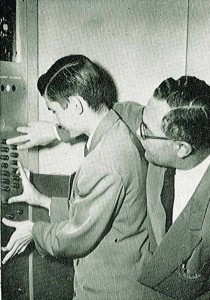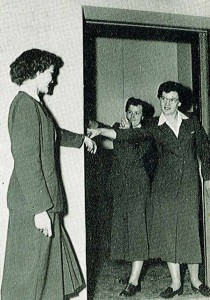-
#ThrowbackThursday: GS Demonstrates ‘Don’ts’ for Use of Staff Elevators
This article first appeared November 29, 1954 in the publication Mayovox.
“By following a few simple suggestions, you can have perhaps 15 percent better service from staff elevators in the new Clinic building.” This is the promise of Keith Elkerton, elevator maintenance man, and of Clinic people working closely with him. In the panel at right, General Service men and women illustrate some common customs that tend to slow up elevator service for everyone.
“The Two-Finger Spread,” also known as “The Multiple Stab.” Here, about five seconds before this picture was taken, Arvin Lubahn had pushed the “down” button. When no car appeared immediately, he pushed both “up” and “down” on the theory that whatever happened would happen twice as fast.  There are two flaws in this theory, First, the elevator going his way won’t arrive any faster. Second, a car going in the other direction will now stop at this floor,
There are two flaws in this theory, First, the elevator going his way won’t arrive any faster. Second, a car going in the other direction will now stop at this floor,
thus delaying people waiting on other floors.
“The All-Button Punch”, also subtitled “The Two-Octave Spread.” Each car at each floor pauses for a few seconds before—automatically –beginning to travel in sequence with the other cars. Here Donald Phillips and Donald OStrom entered the car, pushed the button for the floor they wished to go to. When the doors did not close at once, Phillips and Ostrum tried to get things stirring by producing other buttons. Again, there are two flaws in this reasoning. Operating mechanically, the elevator wouldn’t start any faster if they were to push every button. Second, the car will now stop at every floor for which a button was pushed.
“The Cordial Door Block” also called by experts “The Cordial Door Block” also called by experts “the Tardy Yoo-Hoo. Cubby Cunningham and Shirley Evenson entered this car and pushed the button for the desired floor.  As the doors began to close, far down the corridor and sprinting briskly came friend Donna Plank. As Cubby shouted encouragement, Shirley Braced foot, arm and hand to hold open the closing doors. Again, two flaws in the reasoning here. First, Donna would get another elevator in a matter of seconds. Second, when this maneuver is multiplied by a dozen different sets of friends on a dozen different floors, it plays havoc with the mechanical schedule of the whole elevator system.
As the doors began to close, far down the corridor and sprinting briskly came friend Donna Plank. As Cubby shouted encouragement, Shirley Braced foot, arm and hand to hold open the closing doors. Again, two flaws in the reasoning here. First, Donna would get another elevator in a matter of seconds. Second, when this maneuver is multiplied by a dozen different sets of friends on a dozen different floors, it plays havoc with the mechanical schedule of the whole elevator system.
Impossible to illustrate without color printing, but equally unfortunate, is what has become known as “The Low-Level Look” or “He Went Thataway, Raging.” This frustrating happening arises when a preoccupied person steps into the first elevator that stops on a floor, without looking at the red and white direction lights above each door. To take an example, say you are on the Eighth Floor and want to go up to Ten. You step into a “down” elevator--then protest bitterly (and uselessly) at stops on Six-Five-Three-Main-Basement-Two-Four-Six-Eight (again) Nine-Ten.
Summarizing, Elkerton suggests: Let the mechanical automatic system do the thinking. If you do, we can promise that you’ll get where you’re going faster. The main things to remember are, first get on a car going in the direction you want, and, second, push only the button for the floor you want.
Related Articles







